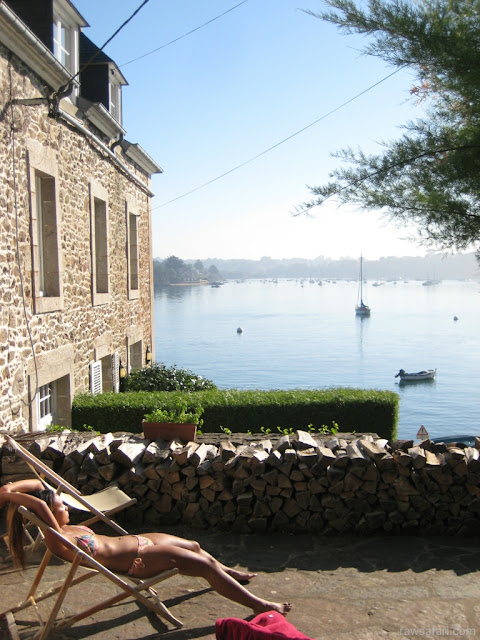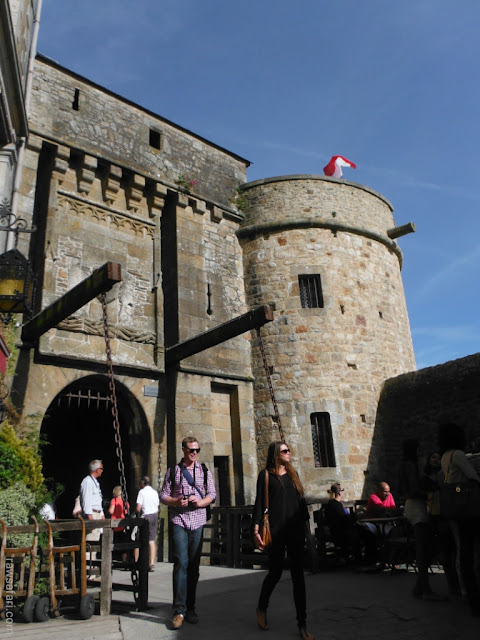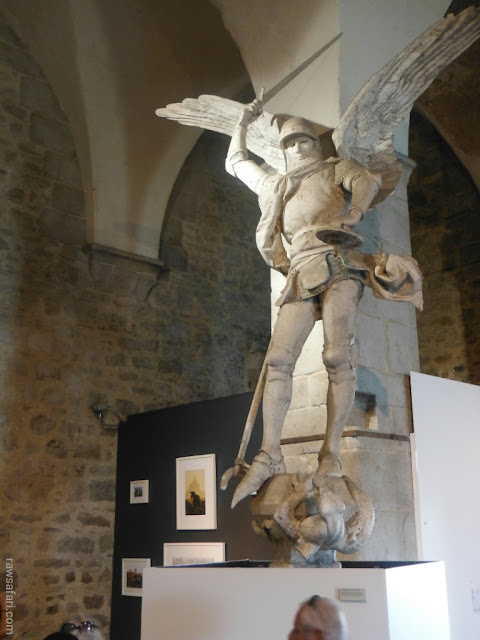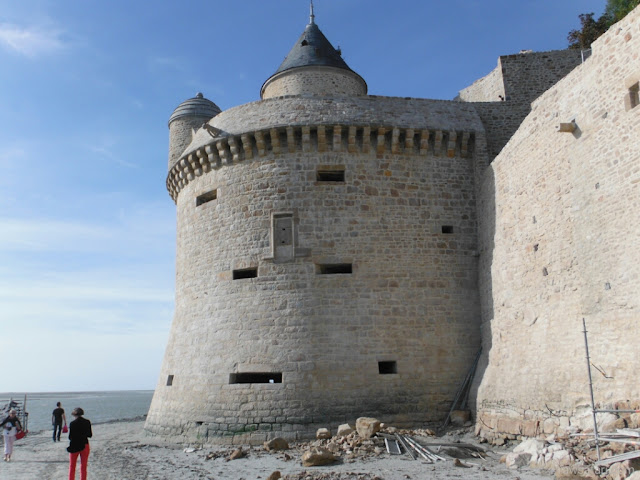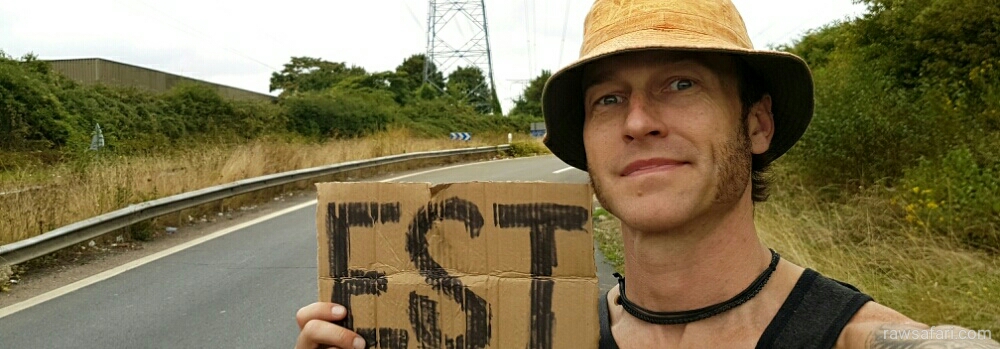…I feel like a pilgrim to a palace from Lord of the Rings. The island is completely covered in medieval stone structures, walled around with soaring battlements, and topped with a sky piercing spire adorned with a gilt statue like an angel. Sea birds circle the island, and here and there men are walking across the sand flats barefoot, with baskets, collecting shellfish…
I nerded out pretty badly at Caen, I will admit, but my inner Dungeons and Dragons geek really comes to the fore at Mont-St-Michel.
After we leave Caen, we hitch south-west, toward the Normandy coast. We get rides with three French female drivers in a row, two of them with their daughters on board, and any lingering doubts about the viability of hitching in France are well and truly quashed. All our drivers know a few words of English, and we are competent mimes, so communication is not a big issue.
Late in the afternoon we reach Mont-St-Michel. Actually, we reach the edge of the delta Mont-St-Michel is in the middle of. The city is on a precipitous island, surrounded by a vast sandy estuary which is utterly flat and featureless. The impact of the city could hardly be greater. As you approach the spires are visible from 15 km away, looming above the horizon.
Visitor’s vehicles are forbidden, so our ride drops us off at the parking lot on the mainland. From the end of the public road to the gates of the city is a walk of about 5km.
We ditch our packs in a cornfield, and set out across the delta. On either side of the causeway, which is the only high ground, the sand stretches like a muddy desert. Rivulets of tidal water stream past in narrow channels here and there, but the tide is low, so they are sparse and narrow.
I feel like a pilgrim to a palace from Lord of the Rings. The island is completely covered in medieval stone structures, walled around with soaring battlements, and topped with a sky piercing spire adorned with a gilt statue like an angel. Sea birds circle the island, and here and there men are walking across the sand flats barefoot, with baskets, collecting shellfish.
To successfully navigate the delta requires a bit of local knowledge. Signs beside the raised road warn pedestrians to be cautious of quicksand on the flats.
There is a legend from the middle ages that an army attempting to invade Mont-St-Michel was consumed by the sea. The heavily armoured infantry set out across the delta at low tide. The famously swift Mont-St-Michel tide turned as they were half way across the bay, and to their dismay, the soldiers suddenly found themselves wading through ankle deep water, which turned the sand to treacherous mud. In panic, the encumbered army struggled forward, but the tide rises quickly across this flat estuary, and the water rapidly became knee deep, then swallowed the thrashing army altogether.The legend is easy to believe. As we approach the gates of the city, the tidal rivulets become rivers before our eyes. By the time we have walked under the arched gateway, and mounted the first rank of battlements the city walls are surrounded by a lapping tide, and the desert has become a salty swamp. The water level in the bay steadily rises as we climb the steep winding roads of the town.
Mont-St-Michel is superbly preserved, and behind the gaudy gift shop displays, and restaurant menus, is the stolid stone, and massive timbers of the medieval architecture. Construction and restoration on the city has been more or less continuous since the 13th century. Carved dates on foundation stones range right through to the 19th century, and restoration work continues all over the city.
In 2006 a massive project was commenced to defoliate and re-point the thousands of metres of stone walls and seal them against the elements, and the work still goes on. The crowds of tourists stream endlessly across the bay, and through the city gates, so clearly the preservation of Mont-St-Michel is a good investment for the people of Normandy.
Only a handful of people actually live on the island. The majority are monks who live in the Abbey at the top of the island. The rest are employees of the French Ministry of Culture; curators, historians and tour guides.
(Above: the massive, muddy, flood plain of the estuary seen from the castle)
Seeing Mont-St-Michel is hard on the legs. The roads are extremely steep, and we traverse thousands of steps to get around the island. Everywhere I look there are extraordinarily beautiful sights: architectural curiosities, traces of the medieval world, and panoramic views of the Normandy coast.
The only part of the city that requires a ticket to enter is the Abbey itself, at the islands top. We sneak into a side door which is ajar for a moment and manage to see part of it gratis though.
We trudge back to the mainland just before sunset, exhausted, footsore and with flat camera batteries. The hitching opportunities are lousy on the narrow roads near the bay, so we end up walking to the nearest small village, buying a loaf of bread and bedding down for the night beside an incongruously placed reptile theme park.
The next morning we find a decent pitch outside the village and stick our thumbs out and along comes Pierre. Pierre is a gently spoken middle aged man with a sportsman’s tanned face and muscular build. He tells us that he too has been a hitchhiker and wayfarer, and invites us to have a shower and some lunch at his home. We accept gratefully and he drives us to his house, at Mont-St-Michel.
We can hardly believe our luck. We get the V.I.P. treatment, driven past the trudging tourists right through the city’s front gates. Pierre waves his ID card at the gendarme at the gate, and we walk up a flight of stairs to his stone walled apartment. Pierre, it turns out is fortunate enough to have an old friend who works for the Ministry of Culture, and is therefore one of only 6 non-monks allowed to live on Mont-St-Michel.
Open mouthed, we sit at Pierre’s kitchen table, looking out over the flooded estuary, and the battlements of the city walls.
We have coffee, red wine, and when Pierre’s friend Jean-Marc arrives we sit down to a mouth watering pork roast Pierre has prepared. Pierre shows us Jean-Marc’s collection of historical postcards of the city. They are mostly used, with hand penned messages in italic french, and show sepia toned visions of the city surrounded, as ever, by tourists, but in top hats, and climbing out of horse drawn carriages. Pierre also shows us photos on his phone of king tides which flood the city courtyards 4 or 5 times a month, and prevent even the privileged few from gaining access by car.
We have showers, which are our first for more days than i want to admit, and wander around the side of the island most tourists don’t see.
I tell Pierre I am particularly taken with a very small simple chapel just above tide height on the seaward side. He informs me that this was the first structure on the island. I ask Jean-Marc, who is a historian and tour guide, about the origins of the city. Was it all French built, or a sometime possession of the British like Chateaux Ducal, in Caen. He shakes his head.
“We don’t know. The history of the city is shrouded in legend, and very unclear.”
“The fucking British,” Pierre grins, “Probably they try to take le Mont.”
After lunch Pierre offers to show us the city of St Malo. It is about 40km west of Mont-St-Michel, and Pierre’s home town. St Malo is spectacular. Green, sunny, chock full of history, and hemmed around with beaches that make Bondi look drab.
Pierre shows us a beautiful caravan park / camping site on the cliff tops above the city, but we explain that the fifteen euro fee is our food budget for the next week. Pierre, himself a former hitchhiker laughs sympathetically, and tells us he knows a nice quiet place we can camp on the river, with no fee.
“Maybe you will like it better”, he shrugs, “you will see and you can decide.”
We drive into the countryside toward St Antoine. Pierre talks about his life as a sailor. He has been obsessed with boats since he was fourteen and took his fathers boat on a spontaneous 3 day voyage (much to his parents dismay). In 1985 he was part of the French team that won a eight month round-the-world yacht race, and he hopes to compete in the Sydney to Hobart race one day.
We drive down quiet country roads along the river. The water is blue, and the banks are dotted here and there with stone houses and mansions. I can see plenty of good camping spots on the river bank, and tell Pierre, so. He stops at a grocery store so we can get some supplies, and then we roll down a narrow cobbled road to a quiet lane beside a jetty.
We climb out of the car, and I can see we are a ten minute walk from the nearest woodland, but Pierre has been such a generous host, I don’t want to strain the friendship by asking him to drive us any further.
We look out at the beautiful river together.
“Tres Bon.” I say. “Merci Pierre.”
“You like it?” he asks.
“It’s perfect” I say.
Pierre looks pleased.
“It is the most beautiful place in the world.” he says.
Pierre turns and walks into the garden of the house beside the jetty.
“You can camp here if you like” he gestures at the lawn in front of the house.
I am about to explain that perhaps the owners of the house may be a bit anxious about having us on their front lawn, when Pierre pulls out a set of keys and unlocks the front door.
“Or, if you prefer, you may camp here”, he says with a sly smile.
We follow him inside and he takes us on a tour.
“You can sleep here,” he says indicating a comfortable looking room next to the kitchen.
We gape with joy. Real beds! With mattresses!
“Or…” Pierre continues, climbing the stairs, “you can sleep here.”
We step into a snug top floor bedroom with a luxurious looking double bed, and a stunning view, through a bay window, of the river and jetty.
We don’t have the French to express our feelings. Actually, we don’t have the English either, so we just give Pierre hugs.
Pierre’s house is a three storey stone cottage. It is beautifully decorated, immaculately tidy, and looks out over the river. In the back yard Pierre shows us his fruit trees, and apologises that only the plums are ripe right now.
“It is yours for the week,” Pierre proclaims, and hands me the front door keys. “Enjoy yourselves.”
We thank Pierre with as much self control as we can manage under the circumstances, and he drives away beaming from ear to ear.We swim in the glassy clear water of the river, and eat our sausage and baguette watching the sun set.
Sitting here typing away, and watching Nia sunbake on the patio, I am once again astonished by the bond that exists between travelers, and the generosity people are capable of if you give them the opportunity.
More on Saint Antoine later, but right now the sun is out, and the river is irresistable, so…
(5 Star camping at Saint Antoine.)
(Above: mediaeval stone carvers had vivid imaginations…)
(Below: …and wicked skills)
(I said “wow” so many times at Mont-St-Michel my lips ached.)
(Jean-Marc’s awesome postcards.)
(The modest original chapel that was the first built on the island.)
(Me, Pierre, and Nia.)
>> Did you enjoy reading this post? Please share it with your friends on Facebook: click here!
Hi!
Manny here, the guy who makes this blog.
Want to start an adventure of your own?
Download your FREE copy of my e-book: The Raw Safari Travel Hackers Handbook and learn how to see the world on $10 a day!
Everything I’ve ever learned about low-budget adventure is in this book.
Get it now, for free: click here!



